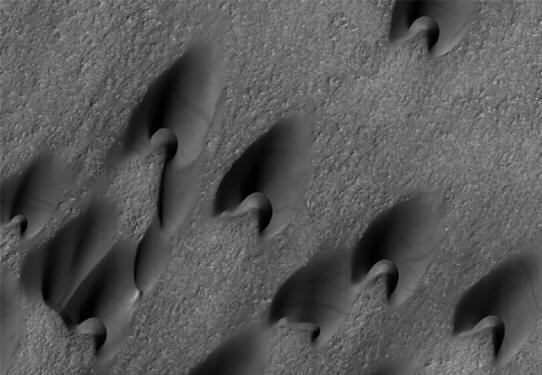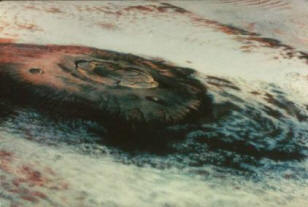|

Dunes on the western edge of
Arkhangelsky crater. Credit: Credit:
NASA/JPL/University of Arizona
Craters and Dunes
Nov 19, 2010
Why are the bottoms of many
craters on Mars filled with
so-called "sand dunes"?
The atmospheric density on Mars
is less than 1% that of Earth. It is
composed almost entirely of carbon
dioxide, although nitrogen and argon
make up about 3%, with trace
elements less than 1/10%. The
temperature on Mars varies from a
maximum of 20 Celsius to a minimum
of -140 Celsius. The atmosphere is
so thin that winds blowing at nearly
300 kilometers per hour exert almost
no pressure.
Since the winds exert little
force, what caused the formation of
the many
dune fields on Mars? Why
do they also appear to be fresh
looking and sharply delineated? Many
of them are textured with
fingerprint-like patterns or, as in
the image at the top of the page,
with
scorch marks. In many
cases, the dunes lie on top of
quartz deposits that exhibit
polygonal fracturing over
a wide area.
Finding
sand ripples or dunes on
other planets incites the assumption
that similar activity created what
look to be the same kind of
formations on Earth. Since sand and
dust from wind and water erosion are
presumed to have created the dune
fields found here, then Mars "must
have" had an environment at one time
that provided the same conditions
for them to form there.
Is projecting an Earth-like
environment onto other worlds the
right way to go? Should planetary
scientists instead use the evidence
from other worlds as a guide for
what might have happened here?
Most sand dunes and ripples
do not move around Mars.
Some research has suggested that a
small dune on Mars might take
more than a thousand years
to move a meter. Recent observations
from the HiRise camera system do
seem to show changes in some dunes,
though, possibly due to the action
of planet-wide dust storms, but
the same press release
announcing dune changes also states
that some of them in other locations
have not moved for 100,000 years.
The observed study area is within
Nili Patera, Syrtis
Major's so-called "collapsed lava
pit."
Syrtis Major is a mere
nine degrees north of the Martian
equator, a region that is sometimes
swept by gigantic dust storms.
The Martian atmosphere is 100
times thinner than Earth and 75
degrees colder, on average. However,
its dust storms are far larger than
those seen on our planet and are
accompanied by multi-kilometer high
vortices, or "dust devils." When the
Viking spacecraft landed on Mars,
planetary scientists were surprised
by all the suspended dust. They
thought the sky would be dark, since
the atmosphere is so thin that it
should be too weak for small
particles to blow around, let alone
to raise such monstrous dust devils.
NASA scientists studied the dust
devils in Arizona in order to
understand what possible causes
generate them on Mars. They
discovered an electric field of up
to 10,000 volts per meter associated
with dust devils on Earth. This
means that dust devils on both
planets are an atmospheric electric
discharge phenomenon similar to the
electric winds produced by air
ionizers. Perhaps it is ionic winds
that are changing the shape of the
dunes under consideration.
The dunes in Nili Patera are
blackened, possibly due
to the vast electric discharges that
created them.
When electricity passes through a
solid body, such as a planet, the
current pulls charged material from
the surface where the arc makes
contact. Neutral dust and stones
will be pulled along with the
ionized particles as well. Craters
formed by the arcs are most often
circular because electromagnetic
forces cause them to maintain right
angles to the impact zone.
Since two or more filaments
rotate around the arc axis, it can
behave like a drill, excavating
steep side walls and "pinching" a
rolled rim. Often, the filaments
will leave behind a central peak.
Minerals in the crater will be
electrically heated, scorched, and
melted. This explains the scorch
marks found on the Arkhangelsky
crater dunes shown at the top of the
page.
As Electric Universe proponent
Wal Thornhill suggested,
a positively charged surface will be
melted, while the electromagnetic
forces within the arc might lift the
surface to form a "lightning
blister,” called a fulgamite.
Olympus Mons demonstrates the
results of such a discharge: a
gigantic mound with several
overlapping craters at
the top and a
vertical drop off at its
edge.
If the surface is negatively
charged, an arc will travel,
sometimes eroding elongated craters,
like the enigmatic "boot-shaped"
crater recently discussed in several
press releases. The arc
might also jump from high point to
high point. Smaller craters on the
rims of larger ones point to this
phenomenon. A series of craters in a
line, otherwise called a "crater
chain," is another sign of
arcing to a negatively charged
substrate.
The advantage of the electrical
interpretation is that it directly
explains the nature of the
topography dominating the craters on
Mars. Electromagnetic forces between
Birkeland currents constrained to a
surface will force them into
alignment. Ionic winds can lift
material and carry it along in the
direction of the current flow. Where
a discharge channel bifurcates, the
branches tend to
remain parallel to each
other and may rejoin. Orthogonal
coronal discharges from parallel
Birkeland currents generate the dune
ripples.
It is most likely electrical
effects that carved the craters on
Mars and in so doing formed the
drifts of finely pulverized debris
that lie at their bottoms.
Stephen Smith
Multimedia

“The Thunderbolt that Raised Olympus
Mons”
|








